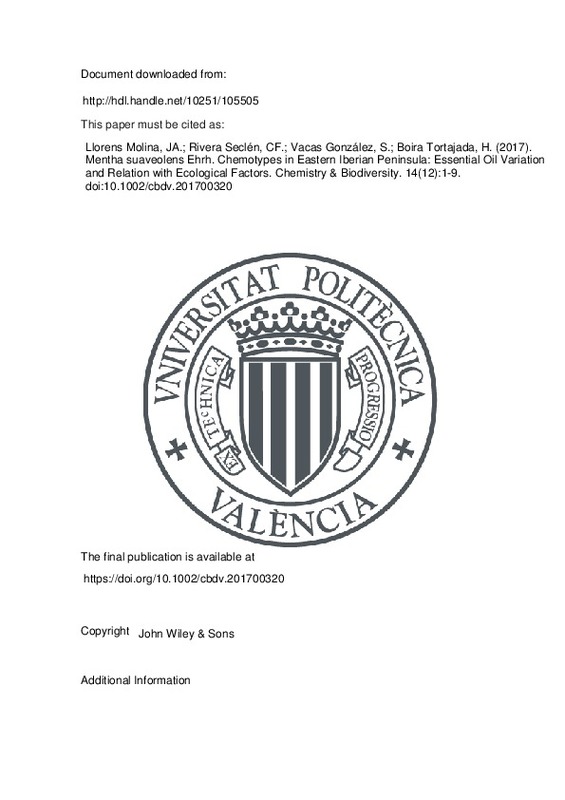JavaScript is disabled for your browser. Some features of this site may not work without it.
Buscar en RiuNet
Listar
Mi cuenta
Estadísticas
Ayuda RiuNet
Admin. UPV
Mentha suaveolens Ehrh. Chemotypes in Eastern Iberian Peninsula: Essential Oil Variation and Relation with Ecological Factors
Mostrar el registro sencillo del ítem
Ficheros en el ítem
| dc.contributor.author | Llorens Molina, Juan Antonio
|
es_ES |
| dc.contributor.author | Rivera Seclén, Cynthia Fiorella
|
es_ES |
| dc.contributor.author | Vacas González, Sandra
|
es_ES |
| dc.contributor.author | Boira Tortajada, Herminio
|
es_ES |
| dc.date.accessioned | 2018-07-09T04:25:38Z | |
| dc.date.available | 2018-07-09T04:25:38Z | |
| dc.date.issued | 2017 | es_ES |
| dc.identifier.issn | 1612-1872 | es_ES |
| dc.identifier.uri | http://hdl.handle.net/10251/105505 | |
| dc.description.abstract | [EN] Essential oil (EO) extracts coming from two representative populations of Mentha suaveolens Ehrh. subesp. suaveolens in Eastern Iberian Peninsula were analyzed by gas chromatography coupled with mass spectrometry and flame ion detector. Plant sampling was carried out in the morning and evening in order to study diurnal variation in EO profiles. Likewise, leaves and inflorescences were analyzed separately. Two chemotypes corresponding to each one of the populations were identified, with piperitenone oxide (35.2 - 74.3%) and piperitone oxide (83.9 - 91.3%), respectively, as major compounds. Once different chemotypes were identified, canonical correspondence analysis was employed to evaluate the effect of the bioclimatic and edaphic factors recorded in each location on the observed differences. Statistical analysis suggested that these chemotypes were closely related to specific environmental factors, mainly the bioclimatic ones. Concretely, piperitenone oxide chemotype can be associated to supramediterranean bioclimatic conditions and soils with major salinity and water field capacity. On the other hand, the most volatile fraction (hydrocarbon monoterpenes) reached its higher level in the morning; specifically, a noticeable amount of limonene was found in morning samples of flowers (4.8 - 10.6%). This fact can be related to ecological role of volatile compounds in order to attract pollinator insects. | es_ES |
| dc.language | Inglés | es_ES |
| dc.publisher | John Wiley & Sons | es_ES |
| dc.relation.ispartof | Chemistry & Biodiversity | es_ES |
| dc.rights | Reserva de todos los derechos | es_ES |
| dc.subject | Terpenoids | es_ES |
| dc.subject | Gas chromatography | es_ES |
| dc.subject | Essential oil | es_ES |
| dc.subject | Mentha suaveolens | es_ES |
| dc.subject | Diurnal variation | es_ES |
| dc.subject.classification | BOTANICA | es_ES |
| dc.subject.classification | BIOLOGIA VEGETAL | es_ES |
| dc.subject.classification | QUIMICA ANALITICA | es_ES |
| dc.title | Mentha suaveolens Ehrh. Chemotypes in Eastern Iberian Peninsula: Essential Oil Variation and Relation with Ecological Factors | es_ES |
| dc.type | Artículo | es_ES |
| dc.identifier.doi | 10.1002/cbdv.201700320 | es_ES |
| dc.rights.accessRights | Abierto | es_ES |
| dc.date.embargoEndDate | 2018-12-31 | es_ES |
| dc.contributor.affiliation | Universitat Politècnica de València. Instituto Agroforestal Mediterráneo - Institut Agroforestal Mediterrani | es_ES |
| dc.contributor.affiliation | Universitat Politècnica de València. Departamento de Ecosistemas Agroforestales - Departament d'Ecosistemes Agroforestals | es_ES |
| dc.contributor.affiliation | Universitat Politècnica de València. Departamento de Química - Departament de Química | es_ES |
| dc.description.bibliographicCitation | Llorens Molina, JA.; Rivera Seclén, CF.; Vacas González, S.; Boira Tortajada, H. (2017). Mentha suaveolens Ehrh. Chemotypes in Eastern Iberian Peninsula: Essential Oil Variation and Relation with Ecological Factors. Chemistry & Biodiversity. 14(12):1-9. doi:10.1002/cbdv.201700320 | es_ES |
| dc.description.accrualMethod | S | es_ES |
| dc.relation.publisherversion | https://doi.org/10.1002/cbdv.201700320 | es_ES |
| dc.description.upvformatpinicio | 1 | es_ES |
| dc.description.upvformatpfin | 9 | es_ES |
| dc.type.version | info:eu-repo/semantics/publishedVersion | es_ES |
| dc.description.volume | 14 | es_ES |
| dc.description.issue | 12 | es_ES |
| dc.relation.pasarela | S\349067 | es_ES |







![[Cerrado]](/themes/UPV/images/candado.png)

